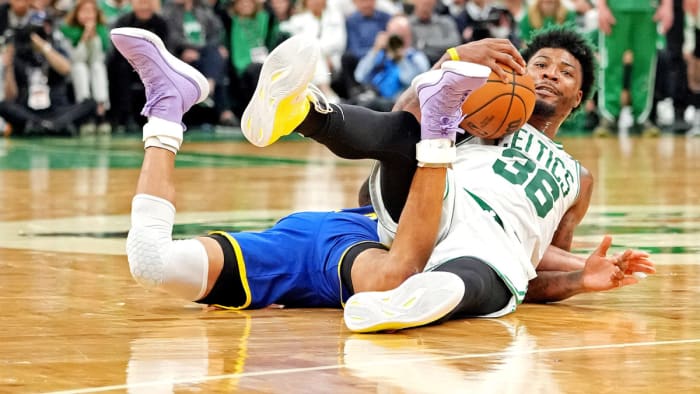It Wasn’t the Celtics’ Time. Next Year It Could Be.
Celtics #Celtics

BOSTON – The construction of the dais for the trophy presentation neared completion and even as a collection of smiling, sweat-soaked Warriors bounced around it, Jayson Tatum couldn’t bring himself to leave the floor. The most successful season in Tatum’s five-year NBA career had ended with its most frustrating night: 13 points on 6-for-18 shooting in a 103–90 Game 6 defeat. As Golden State celebrated, Tatum peered up at the Jumbotron, as if to will a few more minutes on the clock.
“This is tough, getting to this point and not accomplishing what we wanted to,” Tatum said. “It hurts.”

Kyle Terada/USA TODAY Sports
There have been more successful Celtics seasons than this one; 17, in fact, that ended in championships. But few have been more memorable. A team that looked lifeless in November and December rose from the ashes in February and March. Inner turmoil gave way to close-knit chemistry. A rookie coach developed into an elite one. A budding superstar took the next step.
Small consolation, of course. But as recently as mid-January, this Celtics team looked like it was going nowhere. “Start of the season,” said Jaylen Brown, “nobody thought we would be here.” The defense was mediocre. The offense was worse. The team regularly blew fourth quarter leads, after which Ime Udoka publicly lashed them for it. The idea that that team could come within two wins of a title was laughable.
“Stings to come up short,” said Brown. “But there’s a lot to learn and the future is bright.”
It is. Offseason changes will be minimal. Improvements, if they come, will be internal:
“It’s hard getting to this point,” Tatum said. “It’s even harder getting over it, the hump, and win it … it’s tough. You got to take it up another level to do what we want to do.”
Scroll to Continue
“Man, still have a lot to learn as a group, individually,” said Brown. “As much as we made growth, turned our season around, we still got a lot to learn about the game of basketball. I learned so much during this playoff run. Coming from not playing last year after wrist surgery into this year’s playoffs, just being grateful for the opportunity.”
“We see what we’re capable of,” Smart said. “We got a taste of it. We want the whole thing. I know for a fact that we’re going to be back a different team. We’re going to put in the work.”

Kyle Terada/USA TODAY Sports
And that may be all it takes. Improvements in clutch-time minutes, where the Celtics ranked 29th in winning percentage (37.1%) and in the regular season went 3-9 in games decided by three points or less. In the Finals, Golden State outscored Boston in eight of the last 10 quarters. Improvements in cleaning up the turnovers; Tatum finished as the postseason’s leading scorer but also committed more turnovers (100) since the league started tracking them in 1977.
“We’re all going to grind away in the summer,” Udoka said. “Improve in certain ways. I think the biggest part for us is the IQ section. That’s where we saw a huge difference in consistency with us and Golden State, just the little things that experience only can teach you. For us, that’s the message.”
The roster will likely return largely intact. Robert Williams established himself as an elite—and consistent—defender this season. Grant Williams’s three-point shooting took off. Al Horford, at 36, experienced a resurgence and Celtics officials are confident that Horford, who has a partially guaranteed contract for next season, will be back. The bench needs help—the Celtics got five points from the second unit in Game 6—but Brad Stevens will have a $6.4 million midlevel exception and three healthy trade exceptions to play with. Internally, they are high on sharpshooting wing Sam Hauser.
“This is just the start,” Udoka said. “A foundation has been set. We can kind of hit the ground running next year. Let’s get healthy and all be on the same page.”
The Celtics felt this defeat. Perhaps literally. Geographically, the Warriors’ locker room in TD Garden is directly across from Boston’s. It’s likely the Celtics heard Golden State’s celebration in the hallway and at least passed a couple of goggles-wearing Warriors employees walking out the door. It wasn’t their time. With a few tweaks, next year, it could be.
More NBA Coverage: